The Age of Exploration, spanning from the early 15th to the 17th century, marked an era of extensive maritime discovery and global integration that profoundly transformed commerce, including the wine trade. European explorers set sail to find new routes and riches, which led to the establishment of trade links with various parts of the world.
These expeditions had a substantial impact on the global economy, and wine, as a commodity, played a significant role in this transformative period. Wine was not only a cherished beverage but also a symbol of social status, often used to facilitate trade negotiations and as a medium of exchange.
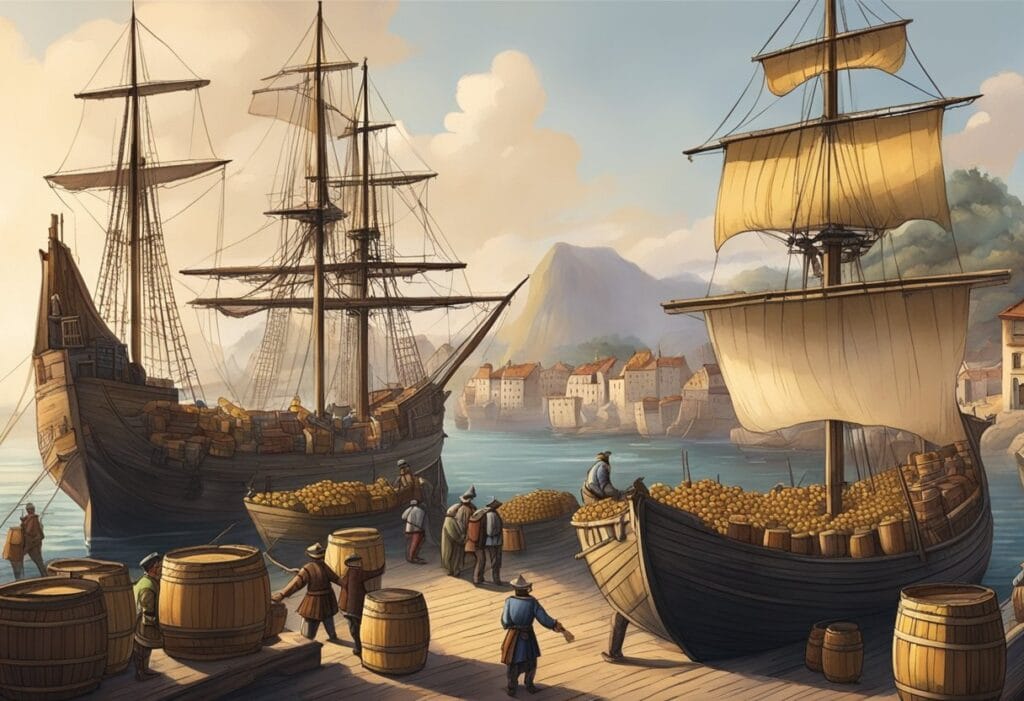
The trade in wine saw notable changes during the Age of Exploration as European powers such as Spain, Portugal, and later France and England expanded their territories and established colonies. This expansion necessitated advancements in winemaking and viticulture to meet the demands of new markets and climatic challenges.
The transportation of wine across oceans led to innovations in storage and preservation, influencing consumption patterns and preferences across continents. Moreover, the cultural and religious connotations of wine prompted its widespread diffusion, intertwining it with the social fabric of newly encountered societies and prompting lasting impacts on local customs and practices.
Key Takeaways
- Wine facilitated trade negotiations and represented status during the Age of Exploration.
- The era prompted advancements in winemaking to cater to expanding global markets.
- The cultural significance of wine influenced its diffusion across new societies.
Historical Context of the Age of Exploration
The Age of Exploration marks a critical period of geographic, cultural, and technological upheavals, which deeply influenced the course of world history. You will discover that motivations rooted in economics and curiosity drove Europeans to chart unknown territories, leading to profound advancements in navigation and shipbuilding.
Motivations and Advancements
Motivations: You are now entering a realm driven by a thirst for wealth and knowledge—a period where Europe’s ambition to expand its riches and power became paramount. The lure of gold, silver, and spices not only promised material wealth but also the potential for increased status on the global stage. Colonialism began to take shape as European powers vied for control over new lands and resources, fueling their economies and asserting their dominance.
With these motivations came the desire to find direct trade routes, especially to Asia, to bypass costly middlemen. Your understanding of the Age of Exploration wouldn’t be complete without grasping the undeniable allure of the exotic goods and the economic benefits that came with controlling their flow.
Advancements: The progress in maritime technology during this time was remarkable. Europeans capitalized on technological advancements such as the astrolabe and the improved compass, coupled with more durable and maneuverable ships like the caravel. These innovations allowed you, the seafarers of the time, to venture further and with greater confidence than ever before.
Success in navigation relied on these key technological improvements, which made it possible for explorers to establish and maintain longer sea routes. You will see that these advances not only facilitated the growth of European empires but also sowed the seeds for the interconnected world you are familiar with today.
Geographical Discoveries and Sea Routes
During the Age of Exploration, monumental geographical discoveries and the establishment of sea routes revolutionized trade, including the trade of wine. This period marked the dawn of new trade routes that connected the Old World to the New, shifting the dynamics of how trade, including the wine trade, was conducted.
Key Voyages
You can trace back the pivotal moments in navigation to a few key voyages. Christopher Columbus’s 1492 voyage, sponsored by Spain, led to the discovery of the New World, opening up new avenues for trade and colonization. Meanwhile, the Portuguese explorer Vasco da Gama circumnavigated the Cape of Good Hope in 1497, securing a sea route to India, which later became essential for the spice and wine trade.
Discovering New Lands
The Age of Discovery was marked by the unveiling of lands previously unknown to Europeans. The Portuguese and the Spanish led this charge, extending their empires to North America and beyond. The discovery of Madeira Islands and the Azores, fertile with wine-producing potential, by the Portuguese changed the wine landscape. Similarly, the Dutch exploration of the New World contributed to the expansion of knowledge in geography and potential wine regions.
Impact on Trade Routes
With the fall of Constantinople in the Middle Ages, Europeans needed new routes to Asia. Explorers searched for alternatives, which led to the dominance of sea-based trade routes around Africa and towards the Red Sea.
These routes notably connected Europe with lucrative markets in India and China, revolutionizing the way goods, including wine, were traded. By bypassing traditional land routes, European powers gained direct access to the wealth of Asia, cementing sea trade as the backbone of their economic progress for centuries.
The Role of Wine in the Age of Exploration
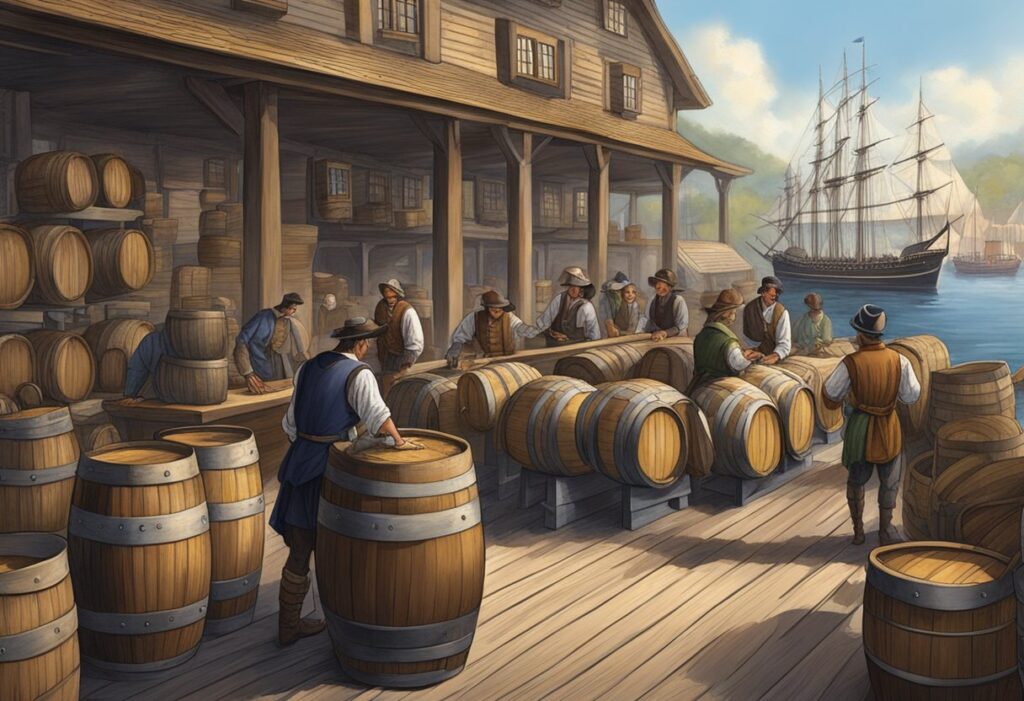
During the Age of Exploration, wine not only served as a staple beverage but also played a crucial role in the economic and cultural exchanges between the Old and New Worlds.
Wine as a Strategic Commodity
Wine was much more than just a refreshment during long sea voyages; it was a strategic commodity in international trade. As Mediterranean civilizations had mastered winemaking, these skills were transported along with V. vinifera, the primary grapevine species, to newly discovered territories.
Regions with a heritage in Italian wine history paved the way, utilizing wine for both political and economic leverage. The importance of wine in diplomacy and trade negotiations was paramount, with nations like France becoming renowned for their wine production, influencing the development of new wine varieties.
Influence on Global Wine Trade
The wine trade burgeoned as a result of the Age of Exploration. European countries established colonies around the world, transporting their knowledge of fermentation and viticulture. This knowledge transfer led to the establishment of local wine industries, which increasingly participated in global trade. For instance, Napa Valley‘s rise as a producer of California Cabernet Sauvignon is tied to these early movements of viticultural knowledge and plant material across the oceans.
Prominent Wine Trade Routes
Significant wine trade routes were mainly established around European coastal cities with shipping capabilities. As explorers sought new lands, they also opened up routes for the wine trade, expanding the reach of European wines by establishing colonies that eventually started their own winemaking traditions.
Maritime expeditions fostered the exchange of wines between the Old World and New World, altering long-standing wine markets and leading to new alliances and even conflicts – where wine and war were intertwined.
By combining the old with the new, the Age of Exploration indelibly shaped the path of wine and its cultural significance across the globe, cementing wine’s role as a central element in the mesh of emerging global trade networks.
Economic and Social Impacts
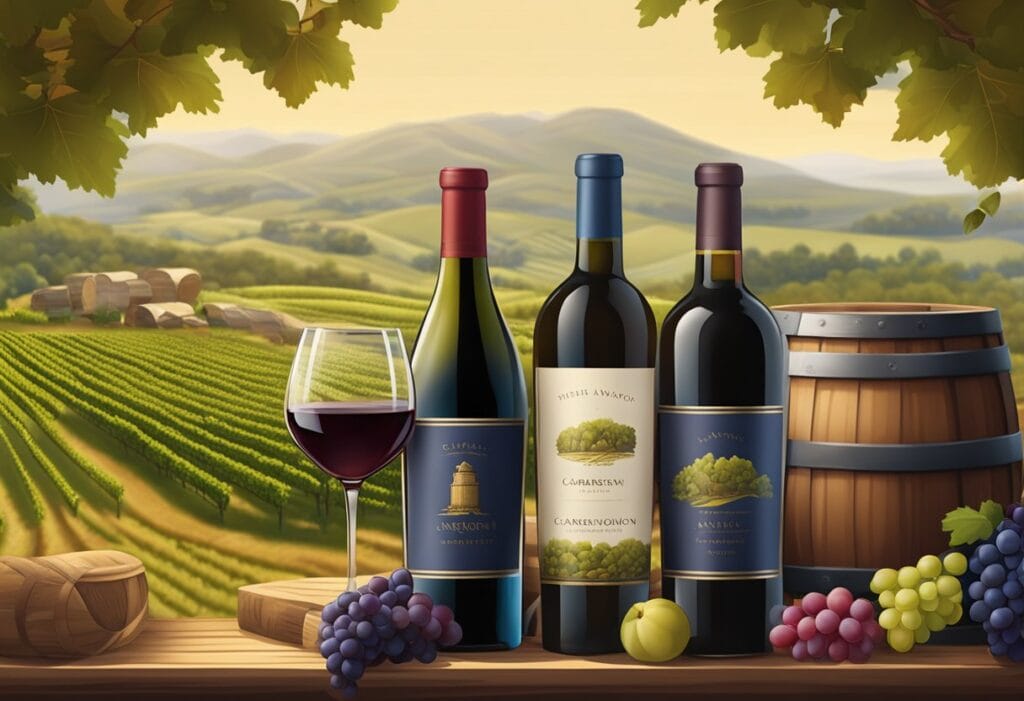
The Age of Exploration significantly shaped the economic landscape and social structures of both Europe and the New World. Focusing on the wine trade, the implications for wealth accumulation, cultural exchanges, and colonial economies were profound.
Wealth Accumulation
Europe saw an immense accumulation of wealth as the Age of Exploration paved new trading routes. The wine trade became a key facet of this prosperity, with nations like France and England developing sophisticated production methods to ensure their wines fetched premium prices in new markets across the ocean. This not only boosted their respective economies but also financed further expeditions and colonial advances.
Cultural Exchanges
Wine, as a commodity, was more than a mere drink; it became a medium of cultural exchange. European vintners introduced their wine to the New World, while European demand for exotic products grew. This led to a blend of tastes and preferences that transcended borders. The exchanges went beyond commodities, including animals, plants, and sadly, even humans, as the trade of slaves became a dark side of this era.
Colonial Economies
In the New World, colonial economies were often kick-started by the wine industry. European settlers established vineyards using new world resources, adapting European progress in viticulture to new environments.
This had a multifaceted impact: while contributing to the wealth of the colonies, it also fueled the displacement of indigenous people and the spread of disease. The colonies’ role in the wine trade echoed back to Europe, intertwining their economies in a cycle of demand and supply, underpinning the economic structures that are still in play today.
Within the complex history of the wine laws during the medieval times, it’s essential to grasp how these regulations have evolved and the impact they had on later wine production and trade practices. You can explore the intricacies of ancient viniculture regulations through a well-documented examination of medieval wine laws.
Advancements in Viticulture and Winemaking
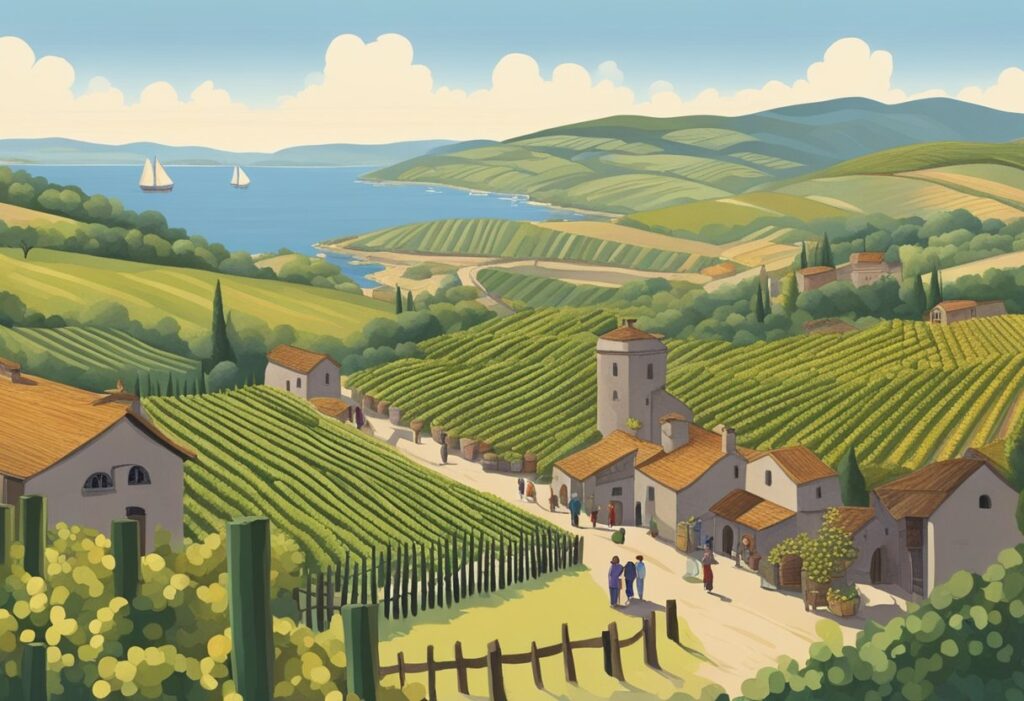
During the Age of Exploration, shifts in viticulture and winemaking had a profound influence on the world. These changes expanded wine production from Europe to the New World, and technological innovations improved the quality and diversity of wine.
European Viniculture
In Europe, particularly in countries like France, Spain, and Italy, a deep understanding of local plant varieties and agriculture techniques led to the cultivation of renowned vines. France was at the forefront, perfecting the production of champagne. Spain and Italy also contributed significantly, fine-tuning methods for robust wines like Cabernet Sauvignon.
New World Wine Production
As Europeans settled in the New World, so did their grapevines, transforming regions such as California, Australia, Chile, and Argentina into prominent wine-producing areas. The introduction of European wine plants into the diverse climates of South America and elsewhere resulted in a rich tapestry of unique flavors and varieties.
Innovation in Wine Technology
The evolution of wine technology revolutionized wine production. From the use of oak barrels for aging to the scientific precision applied to fermentation, each stride in technology enhanced wine’s complexity and taste. The battle against pests like phylloxera, which devastated vineyards, led to innovative grafting techniques still used to protect European vines.
By understanding these key transitions in winemaking and viticulture during the Age of Exploration, you gain insight into the intricate history that has shaped the modern wine industry.
Cultural and Religious Influences
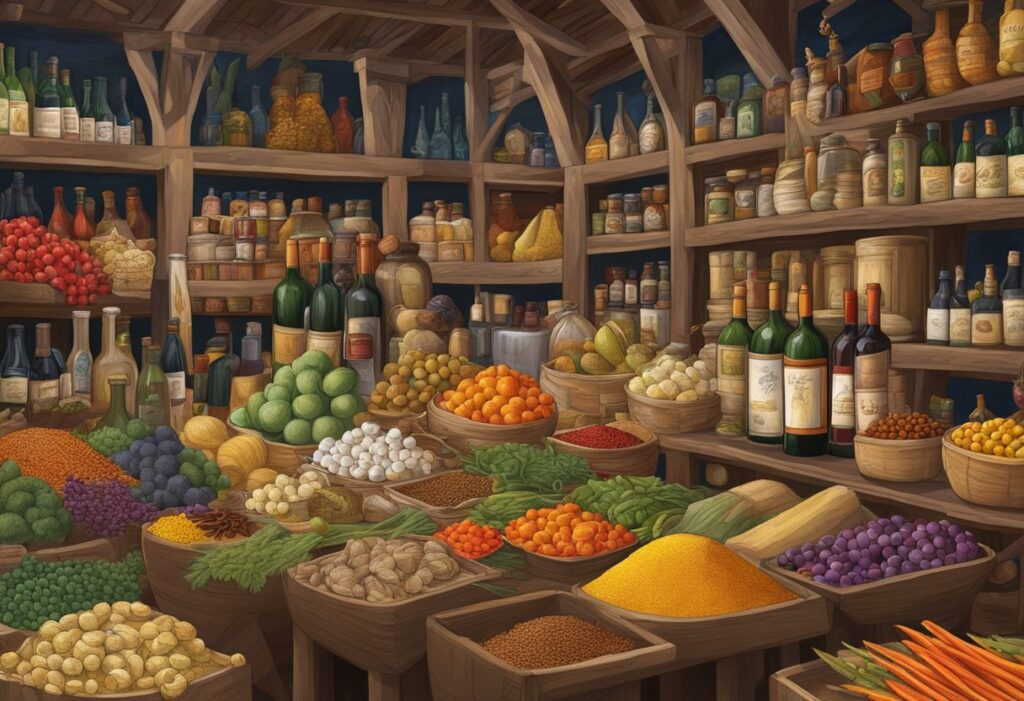
The Age of Exploration significantly impacted the wine trade, as European demand, religious practices, and cultural life interwoven with wine evolved alongside colonial expansion.
Wine in Literature and Art
You’ll find that wine has been a symbolic element in both literature and art for centuries, representing everything from celebration to religious significance. In ancient Rome, for instance, the Bacchanalia festivals celebrated Bacchus, the god of wine, with revelry that made its way into various works of art and texts.
Similarly, during the Middle Ages, wine featured prominently in literature as a symbol of class and status, reflecting in the retelling of tales and paintings of the time, encapsulated by the burgeoning wine culture reflected in medieval wine traditions.
Wine in Religious Practices
As you delve into the religious influences, you find Christianity heavily rooted in the symbolism of wine, particularly within the Eucharist, where wine serves as the blood of Christ. This religious ritual strengthened the wine trade across Christian Europe, including Spain, where sacramental wine was indispensable. Islam’s approach to wine was markedly different due to its prohibition of alcohol, which affected wine trade dynamics in Islamic regions.
However, even within these constraints, fascinating accounts of wine use in religious texts and practices have been documented, reflecting on how wine’s role in religions shaped societies and their cultures. Christianity’s influence spread to the colonies, further extending the reach of wine tied to religious ceremonies.
When exploring further into the cultural aspects of the wine trade, you’ll encounter recommendations on literature capturing the essence of Greek god Dionysus, who was also celebrated and revered in ancient Greek culture, highlighting the longstanding relationship between wine and divinity.
Through these cultural and religious lenses, you can see how wine has historically been more than a beverage—it’s been a profound influencer on the civilization and spirituality of societies.
Influence on Science and Knowledge
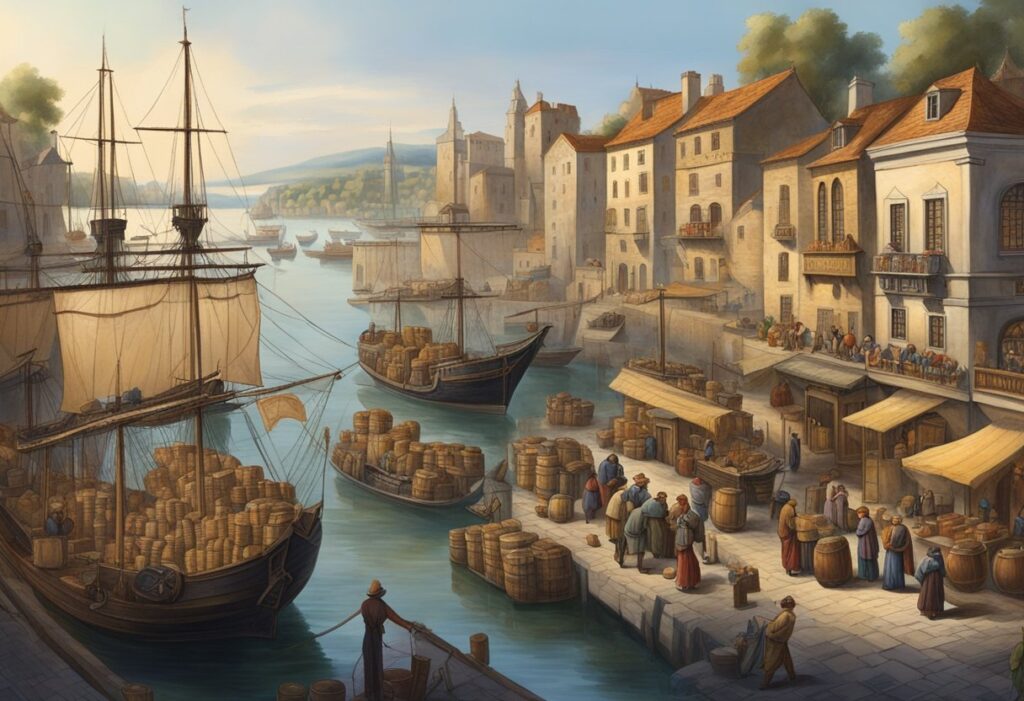
The Age of Exploration significantly impacted your understanding of botany, agriculture, and the historical breadth of wine production across various ancient cultures.
Botanical Studies
During the Age of Exploration, botanists began to systematically study plants including those involved in wine production. Your knowledge of vine varieties expanded as explorers and scientists cataloged new species. Researchers like you delved into understanding plant taxonomy, an essential foundation of modern science, which led to advancements in how you classify and cultivate plants today.
Agricultural Science
The trade and exchange of agricultural practices during the Age of Exploration laid the groundwork for agricultural science. As cultures exchanged knowledge, you learned far more about cultivation techniques, including those for vineyards, enhancing wine quality and diversity. The insights gained from this period remain significant to your current agricultural methodologies.
Archaeological Discoveries
You’ve unearthed ancient wineries through archaeological excavations at various archaeological sites. Findings in regions such as Egypt, ancient China, and Sumer have shed light on the sophisticated wine-making techniques of the Shang Dynasty and other antiquity civilizations. These discoveries not only provide historical context but also inform your present-day understanding of the evolution of wine production.
The Modern Legacy of Exploration Era Wine Trade
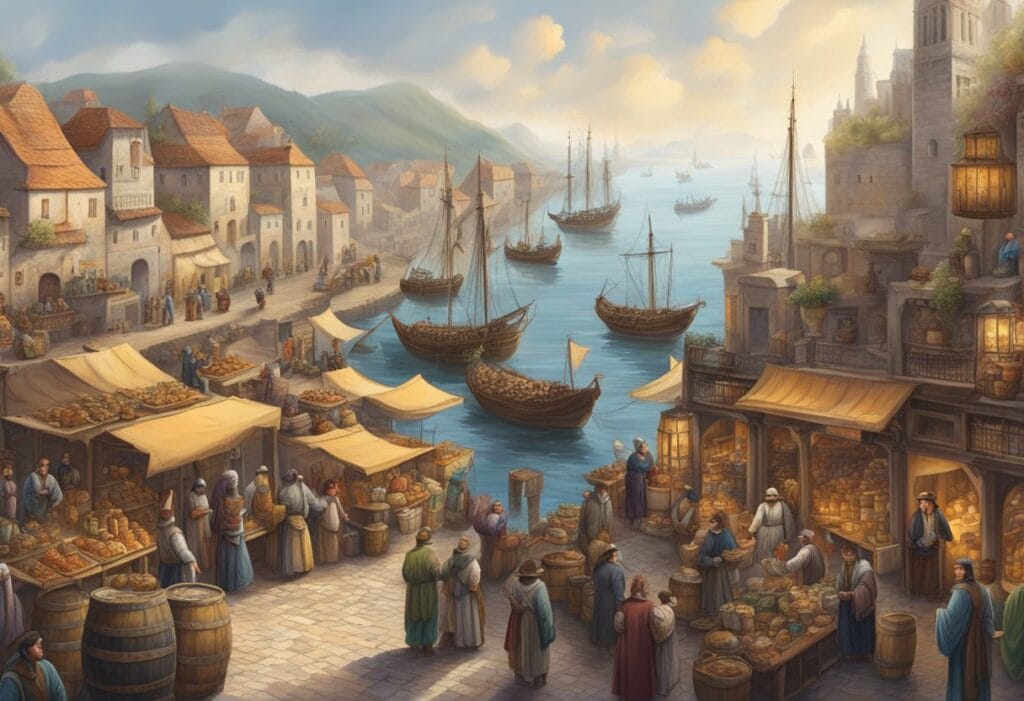
The influence of the Age of Exploration on today’s wine trade is profound, from establishing historical wine regions to influencing trade routes that still impact the industry globally.
Today’s Wine Industry
You can observe the legacy of the Exploration Era in the modern wine industry through the prominence of regions like France and Italy, which have been intricately connected to wine trade for centuries.
The development of New World wine regions, such as California‘s Napa Valley, Australia, Chile, Argentina, and South America at large, underscores a continuing expansion similar in spirit to those early voyages. These areas today are known for innovative winemaking techniques, challenging the old guard with their quality and variety.
United States and California specifically have become giants in wine production, drawing influence from European methods combined with local food cultures and preferences. Historians note how the wine trade routes drawn up during the Exploration Era function as precursors to today’s global wine distribution networks.
Historical Wine Regions and Tourism
The age-old wine regions of France still captivate you with their storied vineyards, becoming beacons for wine-related tourism. Regions like Bordeaux and Burgundy are not just places of production but cultural landmarks, drawing enthusiasts keen to explore the rich history of winemaking. On the other side of the world, places like Napa Valley offer a glimpse into the winemaking prowess of California, a testament to the adaptability of vine cultivation across continents.
New players like Chile and Argentina have turned their wine regions into major tourist destinations, promising an experience that melds historical significance with the allure of discovering something new—much like the explorers of old. South America has seized this heritage, showcasing not only the beverage but also the stories of a time when their lands were just becoming known to the rest of the world.

